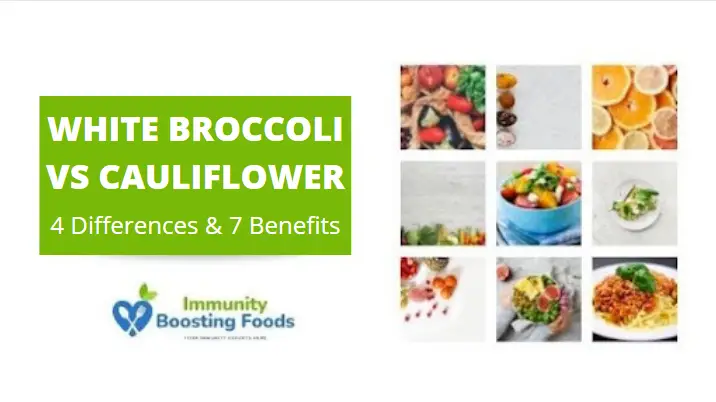Is Cauliflower White Broccoli?
Cauliflowers weren’t to be confused with white broccoli. They’re both brassica plants, and they’re similar species.
In other words, cauliflower and broccoli are cabbage’s immature blooms. Bunched florets appeared to be sprouting from the central axis on both of them.
The distinction would be that broccoli florets are spread apart, but cauliflower florets are tightly bunched.
That is not just but their nutritional profiles differ slightly.
Cauliflower and broccoli would both be descendants of the ancient cabbage, although they come from distinct plant portions.
Cauliflower and broccoli are classified as one species due to their close resemblance; however, their distinct colors, groupings, and structure distinguish them.
I- Differences Between Cauliflower And Broccoli
Cauliflowers have various characteristics or aspects that broccoli lacks. Similarly, some are present in broccoli but are absent from cauliflower. These distinctions demonstrate that cauliflowers are not exclusive to white broccoli.
Let’s discuss the distinctions between Broccoli and Cauliflower:
1. The Structure Of The Florets
Whenever you look closely enough, you’ll notice that, despite their similar appearances, cauliflower and broccoli have distinct structural differences.
The stalks of broccoli are easy to see, but the solid mass of cauliflower is not.
Cauliflower florets are typically tightly packed, but broccoli florets are spaced apart. This is all just one obvious trait, indicating why cauliflowers are not like white broccoli.
2. Difference In Color, With Some Similarities
Cauliflower and broccoli are generally white and green; however, there are several variations.
White broccoli can be found on rare occasions. The florets were smaller & spaced wider apart than cauliflower.
Purple broccoli, a cold-resistant variety, is occasionally available.
The color derives from a natural mutation, just as purple asparagus; however, the inside of the vegetable is still green.
Cauliflower comes in various colors, including a brilliant purple and a yellow-orange that is guaranteed to capture your attention.
3- They Both Have Different Varieties
Cauliflower comes in four different varieties. Northern European annuals, Italian biennials, and Asian cauliflower are among them.
Calabrese and sprouting broccoli are two types of broccoli. Calabrese broccoli is perhaps the most frequent, whereas sprouting broccoli is uncommon.
There are indeed a variety of hues and variants within each category.
4. Slightly Different Nutritional Benefits
Broccoli and cauliflower are both high in nutrients. Both are high in vitamin C and fiber, two nutrients found in almost all vegetables.
The distinction would be that broccoli includes vitamin A, while cauliflower does not, and cauliflower has fewer calories than broccoli.
There is also a difference in flavor. Broccoli is more forgiving here on the palate than cauliflower, and cauliflower is easier to digest than Brussel sprouts.
This is attributed to the reason both broccoli and cauliflower are also cruciferous vegetables, meaning they come from cabbage heads.
We’ve always heard about broccoli and how good it would be for our health. Broccoli appears to be king, with antioxidants, minimal calories, and (some say) fantastic flavor.
But perhaps we should also pay attention to cauliflower and show it a little more love and gratitude.
You might also like Is Broccoli A Flower? Stem or Vege? Is it Invented?
White Broccoli Calories
| Total Calories 31 |
| Sugar 1.5 grams |
| Water 89% |
| Fat 0.4 grams |
| Fiber 2.4 grams |
| Carbs 6 grams |
| Protein 2.5 grams |
White Broccoli Nutrition
| Serving Size: 1 cup, chopped 30 calories |
| 19 mg magnesium (5% DV) |
| 567 IU vitamin A (64% DV) |
| 0.37 mg zinc (3% DV) |
| 43 mg calcium (3% DV) |
| 81 mg vitamin C (90% DV) |
| 93 mcg vitamin K (78% DV) |
| 6 g carbohydrate |
| 0 g total fat |
| 2.5 g protein |
| 2 g fiber |
| 288 mg potassium (6% DV) |
| 60 mg phosphorus (5% DV) |
| 57 mcg folate (14% DV) |
| 0.66 mg iron (4% DV) |
II- Benefits Of Using Cauliflower
A few of the health advantages of including cauliflower in your diet are listed below.
Although these white florets have a strong flavor, you can mask that with some seasonings and garlic.
- Boosts memory: Cauliflower includes choline, a vitamin-like molecule that is necessary for memory and learning enhancement.
Choline facilitates nerve impulse transmission, preserves the integrity of cellular membranes, and improves fat absorption.
- Boosts digestion: Cauliflower is high in fiber and water, though both are necessary for a healthy digestive tract.
Cauliflowers may help you avoid constipation and minimize your risk of colorectal cancer.
- Reduces inflammation: Inflammation is known to be reduced by the bioactive chemicals present in cauliflower.
- Minimize the risk of cardiovascular problems: Cauliflower’s high fiber content minimizes the risk of heart disease.
- Natural components present in cauliflower aid in deactivating potentially harmful substances in the body, thereby detoxifying it.
- It may help you lose weight.
Cauliflower has some characteristics that could aid with weight loss.
To begin with, it’s indeed low-calorie, containing only 25 calories per cup, allowing you to consume large quantities without gaining weight.
- It can also be used to replace high-calorie items like rice and flour with a low-calorie alternative.
- Cauliflower’s high fiber content aids digestion and improves feelings of fullness.
This may limit the number of calories you consume daily, an essential element in weight loss.
III- 4 Ways Of Incorporating Cauliflower Into Your Diet
These were some of the greatest cooking ideas for including cauliflower in your diet while reaping the benefits of its sweet flavor.
- Mash – the same way you’d mash potatoes. If you use a blender, it will be simpler to produce a smooth consistency, but that is not required.
- Rice it, slice it up, then bake or softly boil it. Cauliflower rice is made from small blooms that turn into something resembling grains of rice.
- Use cauliflower in raw salads, cut off from the florets, or blanched for a wonderful crunch.
- Roasting a full cauliflower or cutting it in half is an option. Season & season it like any other roast beef.
IV- Conclusion
While cauliflower and broccoli are not the same things, they are closely related.
Inside the end, it’s a matter of personal preference between which you’d want to be used in a recipe because they’ll all perform similarly.
When you’re feeling very daring, consider a cream soup that includes cauliflower.




